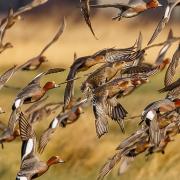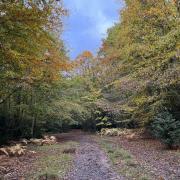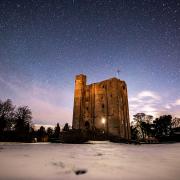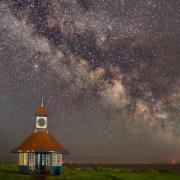What is the dawn chorus?
The dawn chorus begins in the twilight as the sun begins to emerge. At this notice of a new day ahead, songbirds burst into a symphony of whistles, chirps and trills. In the northern hemisphere, the chorus is performed mainly by male birds in the passerine group.
Although most species contribute to the chorus, the symphony builds as time goes on, as different birds join the chorus at different times. Nightingale, robin, song thrush, and blackbird all begin singing an hour or more before sunrise. As light levels increase, they are joined by wren, blackcap, chiffchaff and great tit, before late singers such as chaffinch finally make their entrance. Eventually, the chorus peaks and the cacophony of birds singing unifies to become a single, extraordinary, song.
Why do birds sing at dawn?
Singing at dawn is of such significance to birds, that they remain motivated to do so despite the clamour and competition of many others, which could overwhelm and distort their own song.
Several theories have been proposed to explain why birds sing most intensely at dawn to create this spectacle of sound. These factors can be grouped into three broad categories:
Intrinsic: Including hormone production and energy reserves.
Environmental: Influenced by light levels, climate and habitat.
Social: Based upon mate attraction, territory defence and social interactions.
Here, we explore some of the leading theories.

Using time wisely
Although birds are active at dawn, there is not enough light at this time to forage sufficiently for invertebrates and seeds. Instead, as dawn breaks, birds use this period of the day to sing for a mate until the light returns. Shortly after sunrise, singing ceases because energy levels are low and foraging is now an important task.
Female fertility
During the breeding season, female birds lay one egg every 24 hours at dawn and are at their most fertile up to two hours following laying. It is vital to her partner that he is present at this time. As such, it has been suggested that dawn song acts as a paternity assurance, and guards against neighbouring males seeking to steal their mate. Once the female has emerged from her roost after dawn, the male stops singing and actively protects her.

Defending territories
Perhaps the most convincing evidence that singing at dawn is used to defend territories is provided by migratory species. When males arrive at their breeding grounds and await their female counterparts, song is used as a tactic between male birds to establish dominance and territorial boundaries. Research suggests that when male nightingales arrive at their breeding grounds, they search for territories at dawn, triggering the nightingales that are already present to sing defensively to ward intruders away.
The superior male
Singing is a costly exercise for birds because of the energetic demands of producing song. Such behaviours can develop under sexual selection, if it is difficult to do and uses lots of energy. Therefore, singing can signal the quality of a male bird, and singing at dawn may advertise an abundance of energy at a particularly costly time of day. In blue tits, older, fitter males start singing earlier, and amongst these older males, those that sing earlier attract more mating partners.
Lots to learn
It is widely recognised that a single theory cannot account for dawn song in all species and individuals, and it is likely that several or all theories apply at varying degrees throughout the breeding cycle. Although we do not understand exactly why the dawn chorus occurs, we can still enjoy this natural spectacle from April to June each spring – as long as you do not mind setting your alarm early!
Top nature reserves to hear the dawn chorus in Essex
• Weeleyhall Wood nature reserve
• Brookes nature reserve
• West Wood nature reserve
• Scrubs Wood nature reserve
• Tiptree Heath nature reserve
• Pound Wood nature reserve
• Belfairs Wood nature reserve
• Fingringhoe Wick Nature Discovery Park (early openings will be available on specific dates)

Morning song
The RSPB's Alice Johnson tells us why it’s worth getting up early to hear the dawn chorus
May is a time when spring has firmly established itself across the country. The flowers are blooming, butterflies are on the wing, and birds are raising the next generation. Gardens, local green spaces and the wider countryside becomes a hive of activity as birds pair-up, build nests, raise chicks and defend their territories. One of the most beautiful spectacles of spring is the dawn chorus, which typically commences an hour before sunrise. It may sound early, but we urge you to set your alarm, go outside, join an RSPB guided walk or simply open a window and just listen. The birds’ symphony of layered sound is an incredible uplifting way to start the day.
Birds start to sing as the new day begins from around March to July, and May is a great time to listen to this particularly lively morning birdsong known as the dawn chorus. This incredible cacophony of birdsong starts early in the morning and can go on for several hours. But why do they bother to sing at all? Spring means that it is the breeding season for many species, so the dawn chorus is a way for birds to defend their territories and to attract a mate. These are two important factors if they are to ensure their genes are passed down to the next generation.
Although it is an early start, it is well worth getting up to listen to the dawn chorus at this time of year whether you’re in a city or the depth of the countryside. Listen out for familiar garden birds like the Robin, which sings with a quick and slow, soft and loud voice. This is one species you may have heard singing during the winter months, as they are known to sing near streetlights. A flute-like melody is added to the morning by Blackbirds, and when the sun comes up and the day progresses you will see that the males live up to their name but, confusingly, females are brown often with spots and streaks on their breasts. The bright orange-yellow beak and eye-ring make adult male blackbirds one of the most striking garden birds.
Song Thrushes can be heard with their loud song with repetitive phrases, and Woodpigeons add their soft ‘cooing’ to the morning. This species is the UK's largest and commonest pigeon, and the morning sun will reveal they are largely grey with a white neck patch and white wing patches. Great Tits add their ‘Teacher Teacher’ song, and the delicate call of Blue Tits can also be heard. A colourful mix of blue, yellow, white and green makes this species one of our most attractive and most recognisable garden visitors. However, with so much going on, it can be difficult to distinguish all the species, so coming along to an RSPB dawn chorus walk is a brilliant way to experience this spectacle. Walks are led by experienced guides, who will point out the different bird species that are singing.
The mornings filled with birdsong are such an incredible spectacle that there is even a day created just to celebrate – International Dawn Chorus Day. It takes place during the first weekend of May, and there will be events across the country to celebrate the incredible song of birds here in England. So set your alarm and join in the fun.
To get involved and discover events at RSPB reserves near you, visit www.rspb.org.uk



























